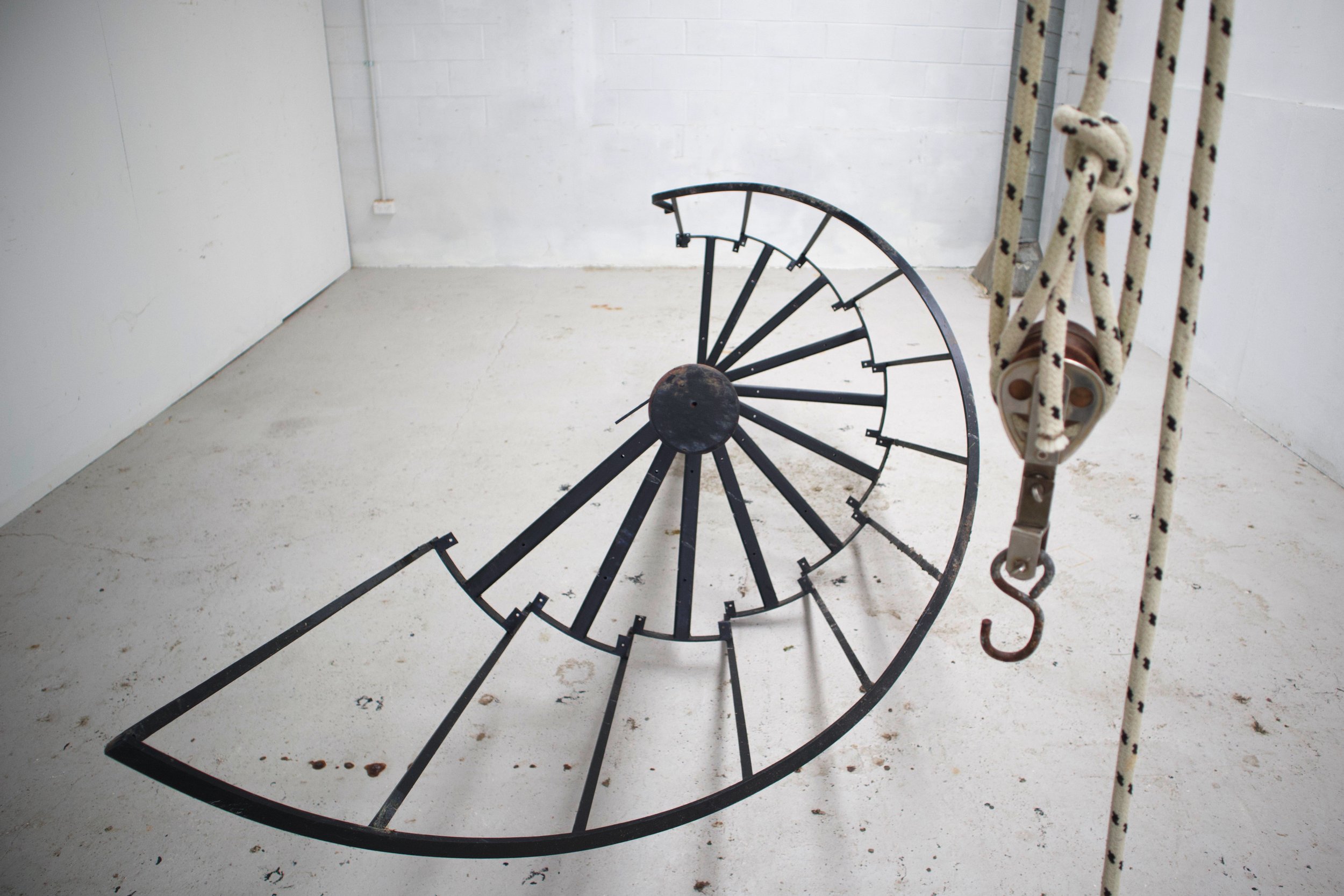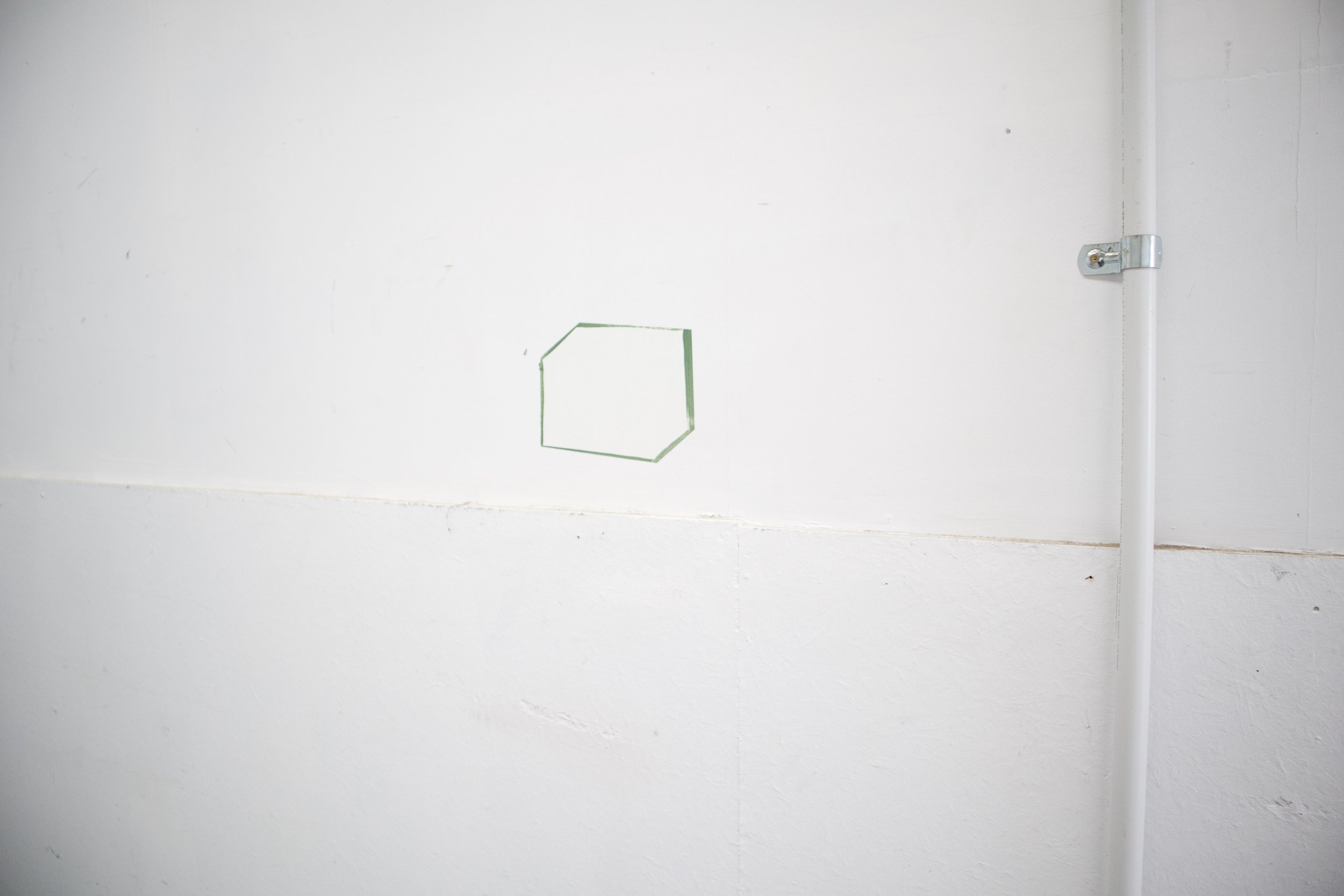Vitrine Workshop / 3b Central Road, Kingsland, Tāmaki Makaurau
18:00hrs 23 August — 16:00hrs 25th August 2024.
*look up the name of the tool.
Considerations, arranged as an open studio.
Indeed right now, what might be done to define non-being through the use of a tool?
In an attempt to clarify a syntax of movement between moments, this exhibition is a waypoint, arrangement as a marker. Sculptural works are provided their own area. Due to a prompt by my former employer, works are positioned within a building formally understood as a site of employment. Now a site of exhibition, the illusion of Schröder's stairs grounds this place as both site and non-site, open for future re-definition.
Constructed outcomes are made of parts, assemblage as drawing, provisional montage, compositions understood as never being complete; ascending, descending, a remedy for fleeting spatiotemporality.
Works:
Navigating illusion, leading to bricolage, Schröder's stairs prompt descent, 2024.
Acrylic house paint, galvanised screws, non-structural ply.
883 x 390 x 818mm
1,2,3,4,5, universal joints, an act to assess the ontogeny of entangled moments (Notes on tending to a vessel, a place to hold assembled parts.), 2024.
Enamel paint, steel, stainless steel, brass, aluminium, ceramic, epoxy and aliphatic glue, Oak, Kauri, Rimu.
Dimensions variable
Step lightly, one step at a time, a helical staircase lies in a room once filled with furniture waiting to be erected, 2024.
Enamel paint, steel, stainless steel, block pulley, polyester rope.
Dimensions variable
In memory of a green field, lines are drawn during play amongst disparate parts, 2024.
Acrylic house paint on wall.
Dimensions variable
Options for trajectory. A four + sided Wilson-Lincoln effect, the prompt to step into a vessel filled with diverted headings — it might be easier - to fail – with land in sight, 2024.
Waterborne enamel and alkyd house paint, oil paint, galvanised/stainless steel screws/staples, liquid nails, epoxy glue, ceramic, concrete, Radiata Pine, structural plywood, non-structural plywood.
220 x 1405 x 970mm
Loulou Callister-Baker on Look up the name of the tool* 10-9-24
A week before the opening of Look up the name of the tool* J.A. Kennedy invited me and a few others to lunch at the former workshop of Vitrine Antique Store in Kingsland, now the artist’s exhibition site. I had never been to the store, which sells restored and unrestored objects from Europe, or its workshop, where those objects were restored. But for Kennedy, the store was a place he had worked for seven years. While he didn't work in that particular location, he had understood it as a “littoral site of employment”, on the metaphoric shoreline of the store. It had been a space both familiar and unfamiliar to him. When his former employer suggested he use the workshop, Kennedy wasn’t sure how to define the space. His subsequent exhibition Look up the name of the tool* guided its visitors through his interrogation of this uncertainty.
On a grey winter day, Kennedy welcomed me through the battered wooden door to the workshop, offering a seat at a table in the middle of his exhibition. Down one end of the table was a portable gas stove top heating homemade soup and a toaster available for slices of fresh bread. There was a warmness to the space, despite its worn concrete floors and exposed wooden ceiling beams. While I waited for the other guests to arrive, I decided to explore. The room next door still looked like an old workshop. It was filled with stacks of old chairs and tables waiting to be restored, as well as numerous miscellaneous materials: all this potential gathering dust. Beyond this room was a kitchenette and a bathroom.
–
When I returned to the exhibition space on opening night, I was drawn to the spiral staircase lying horizontal on the floor in the back of the room, a few metres from where the lunch table once was. From the entrance to the room, the staircase did not look like a staircase at all. Instead, it looked like a metal coil threatening to unravel. I paused, unsure about what I saw. I read the title of this work, Step lightly, one step at a time, a helical staircase lies in a room once filled with furniture waiting to be erected. I followed Kennedy’s instructions. I took a step forward, then another. As I approached, the foil of the coil unravelled. It stretched out across the floor into the metal frame of a spiral staircase without steps. It was an illusion after all.
This staircase did not go up or down. Instead, without floors on either end, it went nowhere. Or perhaps not nowhere, but to and from places I could not see. If you take away the functional use of the staircase, like Kennedy did in this Duchampian move, it doesn’t change what the staircase is, but it changes where it takes you. Perhaps for Kennedy it took him from his former site of employment into this newly defined space.
I thought back to the title of Kennedy’s exhibition, which is a reference to a footnote Albert Camus made in his unfinished and unedited autobiographical novel, The First Man. The tool Camus described in detail but could not remember was likely a draw knife or draw shave in a cooperage. But Camus didn’t have time to look that up, he had to get his observation down and assumed he would fix it up later. I wondered if Kennedy’s exhibition was the description of a tool, the name of which he couldn’t remember (or didn’t need to remember because that wasn’t the point), or was it the reminder to look up the tool’s name?
“[W]hat might be done to define non-being through the use of tool?” Kennedy asked in his exhibition text. If the staircase is a tool then perhaps each end of the staircase led to the “non-being” of the exhibition space, or this could have been another illusion. The space including the staircase could be one and the same, all part of the undifferentiated potential.
Each work in the exhibition led to the next, acting as waypoints through Kennedy’s “garden of creativities” So, where to from this supposed staircase, if we can even call it that? A small, green painting on the wall parallel to the staircase provided a clue. The painting was titled, In memory of a green field, lines are drawn during play amongst disparate parts. The green field could be interpreted in many ways. From hints throughout the exhibition text, I interpreted it as the outline of Schröder’s staircase.
Schröder’s staircase is an optical illusion that you may remember seeing during a science class in primary school. It is a two-dimensional drawing of parallel step-like lines extending from the upper corner of a parallelogram to the lower opposite corner. When you look at the drawing you might see a staircase from underneath, or a staircase from above, or both. One lesson scientific studies on our perception of optical illusions teaches us is that we may not see things as they really are. Instead, from all the sensory information we receive, our brains create stories based on our past experiences to meet our desires and expectations. Our brains work hard to give us answers, rather than leave us uncertain, but these answers are constructs rather than direct translations of our realities.
I looked down at the exhibition text and did a double-take. I realised I had been so focused on the spiral staircase and the painting that I had missed a work at the entrance. I stepped right down it. It turns out Kennedy had built the white-painted ply stairs that led down from the door as a work for this exhibition. The stairs’ title, Navigating illusion, leading to bricolage, Schröder’s stairs prompt descent, is an almost literal guide to the rest of the works in the exhibition. It was the first waypoint, but sometimes we miss the sign and lose ourselves.
Reorientated, these stairs led me to two works that faced each other on opposing walls. On the left wall was: 1,2,3,4,5, universal joints, an act to assess the ontogeny of entangled moments (Notes on tending to a vessel, a place to hold assembled parts.)’. It looked like the oak, kauri and rimu legs of a Manikin figure snaking up the wall, leading to two small hook-like objects made of brass and steel. Kennedy, an experienced sailor, later explained that the wooden objects were tiller extensions connected to each other by a universal joint, repeated. Tiller extensions allow a skipper to be further from the tiller when steering a small boat, which can help them with balance, control and visibility. In this context, the work seemed like a tool to navigate him, and us, from the shoreline of his former site of employment into the waters of this new space. In an act of psychological bricolage and entanglement, Kennedy integrated his separate social identities as a former employee of Vitrine, an artist and a sailor to create and curate his works in ways that gave the former workshop a new definition.
On the opposite wall was ‘Options for trajectory. A four + sided Wilson-Lincoln effect, the prompt to step into a vessel filled with diverted headings – it might be easier – to fail – with land in sight. It looked like a narrow makeshift staircase made of paint on stainless steel, ceramic, concrete, plywood and radiata pine that led up from the floor into the wall. Again, the work seemed like a navigation tool, but unlike the tiller extensions it appeared much more haphazard and uncertain. If the other work was a hopeful integration, then this work was its negative: a pessimistic niggle in Kennedy’s mind wondering whether it would have been best just to stop while he was ahead. If it fell apart, then at least Kennedy could have swum back to the shore where it was familiar. However, the reference to the Wilson-Lincoln effect, another illusion (the name of which was coined by Marcel Duchamp), hinted at a bigger problem: the shore Kennedy remembered actually might be a construction, its apparent safety imagined.
As I caught up with other attendees during the opening I thought about the iterations of the space we were in: a workshop, a place for lunch, a gallery. But by the time you read this, Kennedy’s exhibition will have closed and the space will be interpreted and defined in new ways. The form and function of Kennedy’s works will have changed as well, they may have been broken down into disparate parts, reconstructed or painted over. But Kennedy’s instructions for navigation remain with me: keep stepping lightly, I hear him say, you never know what you’ve stepped away from ... or what you’re stepping into.
































